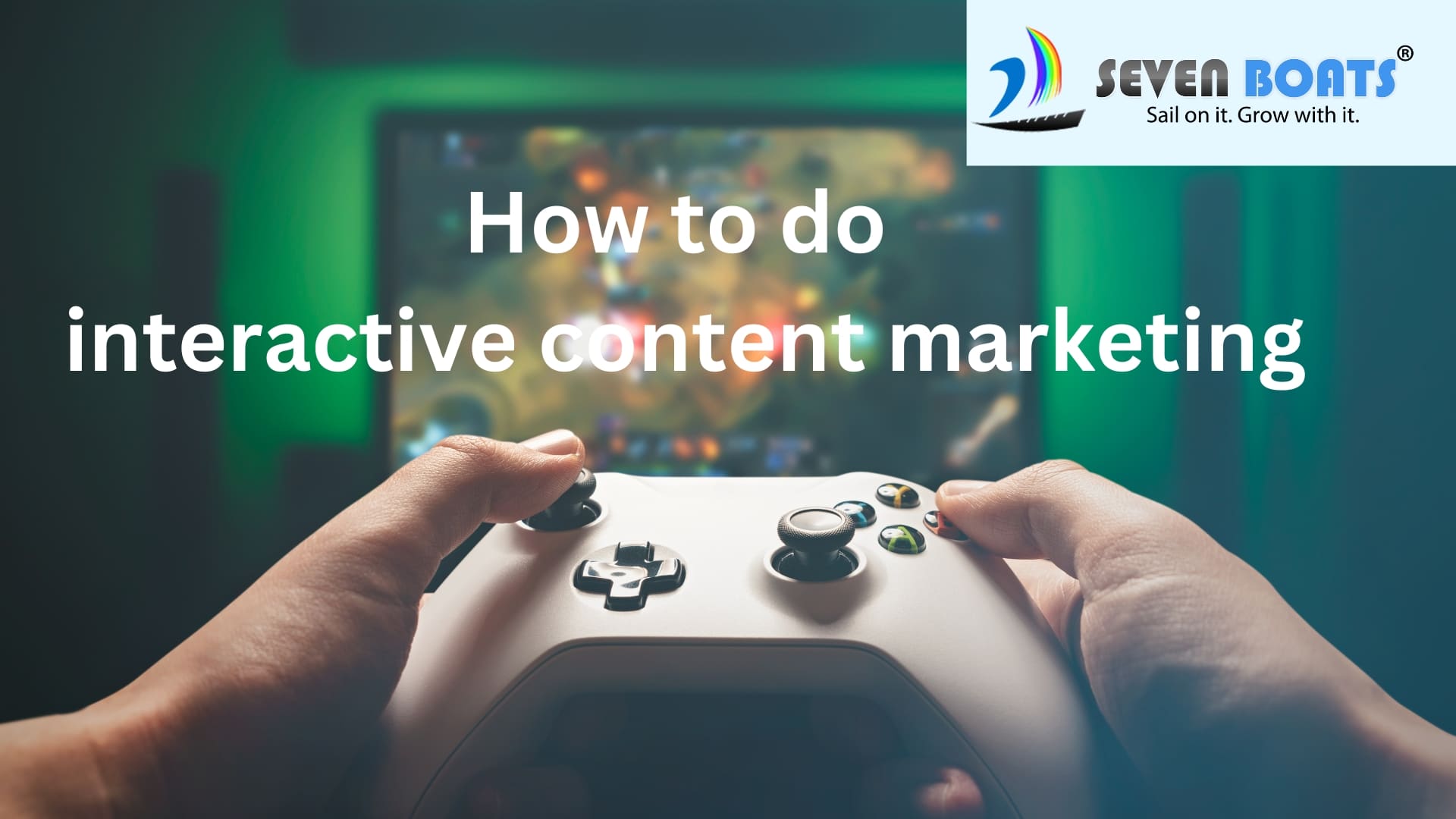Here is a detailed blog post on how to do interactive content marketing:
Welcome to the future of digital engagement! Interactive content marketing is redefining how brands connect with audiences, creating a dynamic two-way conversation that is both engaging and effective. In this guide, we’ll explore the power of interactive content, its various forms, and how you can integrate it into your marketing strategy. Let’s get started!
Mastering Interactive Content Marketing: Boost Engagement and Drive Results
Interactive content is the new frontier in content marketing. Gone are the days when static blog posts and ebooks were enough to captivate your audience. Today, savvy marketers are leveraging interactive formats to deliver engaging, immersive experiences that drive real business results.
But what exactly is interactive content marketing, and how can you harness its power? Let’s dive in.
What is Interactive Content Marketing?
Interactive content is any type of content that requires active participation from the user. Rather than passively consuming information, the audience engages with the content, providing inputs, making choices, and controlling the experience.
Some examples of interactive content include:
- Quizzes and assessments
- Interactive infographics and data visualizations
- Calculators and configurators
- Interactive videos and virtual tours
- Polls, surveys, and feedback forms
- Chatbots and conversational experiences
The key difference between interactive and static content is that interactive content prompts the user to take action. This active engagement leads to higher dwell times, increased information retention, and more valuable data collection for marketers.
The Benefits of Interactive Content Marketing
So, why should you invest in interactive content? Here are some of the top benefits:
- Boosts Engagement Rates: Interactive content is inherently more engaging than passive content. By requiring user participation, you capture and hold your audience’s attention.
- Increases Dwell Time: When users interact with your content, they spend more time on your site, which signals to search engines that your content is valuable and relevant.
- Enhanced Sharing: Engaged users are more likely to share content, increasing your reach.
- Enhances Lead Generation: Interactive content like quizzes and assessments allow you to collect valuable first-party data about your audience, which you can then use to fuel personalized marketing campaigns.
- Improves Conversion Rates: Interactive experiences are more memorable and impactful than static content, leading to higher conversion rates for your offers and CTAs.
- Differentiates Your Brand: In a crowded digital landscape, interactive content helps you stand out and position your brand as innovative and forward-thinking.
- Better Data Collection: Interactive content allows for real-time data collection, providing valuable insights into user preferences and behavior.
Types of Interactive Content
Interactive content comes in many forms, each offering unique ways to engage your audience.
Quizzes
- Example: Buzzfeed’s “What City Should You Actually Live In?” quiz is a viral sensation, engaging users with personalized results.
Polls and Surveys
- Example: Sephora’s Virtual Artist app uses polls to gather user preferences for makeup tutorials.
Calculators
- Example: HubSpot’s “The Ultimate Instagram Hashtag Guide” calculator helps users optimize their social media strategy.
Interactive Videos
- Example: Red Bull’s “Stratos” interactive video captivated audiences by breaking the highest skydive record.
Interactive Experiences
- Example: National Geographic’s “Which Planet Are You?” offers a fun and educational user experience.
Augmented Reality (AR)
- Example: IKEA’s “Place” app helps users visualize furniture in their homes using AR technology.
Dashboards
- Example: Spotify’s “Discover Your Listening Habits” dashboard provides personalized insights into users’ music preferences.
Interactive Webpages
- Example: The North Face’s “The Pinnacle List” lets users create their own bucket list of adventure destinations.
Webinars
- Example: Interactive webinars that allow real-time audience participation and Q&A sessions.
Interactive Infographics
- Example: Dynamic infographics that change based on user input, making data more relatable.
Personality Tests
- Example: Personality tests that provide personalized results, driving higher engagement.
Interactive video example
Interactive Course example
How to Implement Interactive Content Marketing
Ready to get started with interactive content marketing? Here are some steps to follow:
- Understand Your Audience: Start by deeply understanding your target audience – their pain points, interests, and preferred content formats. This will help you create interactive experiences that truly resonate.
- Identify Relevant Use Cases: Brainstorm interactive content ideas that align with your marketing goals, whether that’s lead generation, customer education, or brand awareness.
- Choose the Right Format: Select the interactive format that best suits your content and audience, whether that’s a quiz, calculator, or interactive infographic.
- Optimize for Engagement: Design your interactive content with engagement in mind. Incorporate eye-catching visuals, intuitive navigation, and clear calls-to-action.
- Collect and Analyze Data: Track key metrics like completion rates, time spent, and lead capture to continuously optimize your interactive content for better performance.
How to Create Interactive Content – Tools and Platforms
Creating interactive content is easier than you think, thanks to a variety of tools and platforms available.
Recommended Tools:
- Typeform: Ideal for creating engaging quizzes and surveys.
- Outgrow: Perfect for calculators and personalized recommendations.
- Ceros: Allows for designing interactive infographics and experiences.
- Wistia: Great for creating interactive videos with clickable elements.
- Aweber: Excellent for interactive email marketing campaigns.
Tips for Choosing Tools:
- Evaluate Needs: Determine the type of interactive content that best suits your audience and goals.
- Ease of Use: Opt for tools with user-friendly interfaces.
- Analytics: Choose platforms that offer robust analytics to measure success.
Best Practices for Interactive Content Marketing
Creating high-quality interactive content requires careful planning and execution. Here are some best practices to follow:
Guidelines:
- Know Your Audience: Understand your audience’s preferences and create content that resonates with them.
- Keep It Simple: Ensure that your interactive content is easy to use and understand.
- Provide Value: Make sure the content offers tangible value, whether it’s educational, entertaining, or both.
Tips for Promotion:
- Leverage Social Media: Share your interactive content across social media platforms to maximize reach.
- Email Campaigns: Include interactive elements in your email marketing to boost engagement.
- SEO Optimization: Use relevant keywords and meta tags to improve visibility in search engines.
Measuring the Success of Interactive Content
Tracking the performance of your interactive content is crucial to understanding its impact and optimizing future campaigns.
Key Metrics:
- Engagement Rates: Measure how often users interact with your content.
- Time Spent: Track the amount of time users spend engaging with your interactive elements.
- Conversion Rates: Monitor how many users complete the desired action, whether it’s filling out a form or making a purchase.
- Social Shares: Gauge the number of times your content is shared on social media platforms.
Analysis and Optimization:
- Data Interpretation: Use analytics tools such as Google Analytics 4 (GA4) to understand user behavior and preferences.
- Iterative Improvements: Continuously refine your content based on performance data.
Examples of Interactive Content Marketing in Action:
Here are some inspiring examples to get your creative juices flowing:
Buzzfeed’s “What City Should You Actually Live In?” Quiz
- Success Factors: Personalization and shareability led to viral engagement.
Sephora’s Virtual Artist
- Success Factors: Combining utility and fun, the app enhanced customer experience and drove sales.
National Geographic’s “Which Planet Are You?”
- Success Factors: Educational content that was interactive and highly engaging.
The New York Times’ Interactive Feature on the Olympic Long Jump
- Success Factors: Providing an immersive storytelling experience through data visualization.
Spotify’s “Discover Your Listening Habits” Dashboard
- Success Factors: Personalization and insights into user behavior created a unique user experience.
You can check examples of interactive content marketing from h5p.org
By implementing these steps and drawing inspiration from successful examples, you can create interactive content marketing experiences that not only engage your audience but also drive real business results.
Case studies on Interactive Content Marketing
Here are some compelling case studies that showcase the power of interactive content marketing:
1. Netflix: “Is Your Streaming Habit Normal?” Quiz
- Challenge: Netflix wanted to promote its vast library and keep users engaged on the platform.
- Solution: They created a fun and personalized quiz titled “Is Your Streaming Habit Normal?” Users answer questions about their viewing preferences to discover their unique “streamer type.”
- Results: The quiz went viral, generating over 11 million participants and significant social media buzz. It also kept users engaged on the platform for longer durations.
2. The New York Times: “Snow Fall”
- Challenge: The New York Times aimed to tell a compelling story about a deadly avalanche in a way that resonated with readers.
- Solution: They created “Snow Fall,” an immersive, interactive experience that combined storytelling with multimedia elements like parallax scrolling, video, and 3D animations.
- Results: “Snow Fall” won a Pulitzer Prize, attracted a new generation of readers to the Times, and proved the power of interactive storytelling.
3. Dollar Shave Club: Our Blades Are F*cking Great Shave Quiz
- Challenge: Dollar Shave Club, a subscription-based men’s grooming company, needed to stand out in a crowded marketplace.
- Solution: They launched a cheeky and interactive quiz titled “Our Blades Are F*cking Great Shave Quiz.” The quiz humorously assessed users’ shaving habits and recommended Dollar Shave Club products.
- Results: The quiz became a viral sensation, generating over 260,000 participants and significant media coverage. It helped establish Dollar Shave Club’s brand voice and drive sales.
4. Lego: Rebuild the World
- Challenge: Lego wanted to engage a new generation of kids and promote their creative building sets.
- Solution: They launched “Rebuild the World,” an interactive platform where users could virtually rebuild famous landmarks using Lego bricks.
- Results: The platform was a huge success, attracting millions of users and reigniting excitement for Lego among a younger audience.
5. The Washington Post: Debt Decoder
- Challenge: The Washington Post aimed to empower readers with valuable information about student loan debt.
- Solution: They created an interactive tool called “Debt Decoder.” This tool allows users to input their student loan details and explore different repayment options, personalized to their financial situation.
- Results: Debt Decoder became a valuable resource for millions of users struggling with student loans. It established The Washington Post as a thought leader on the topic and increased brand loyalty.
These case studies showcase the diverse ways interactive content marketing can be used to achieve various marketing goals. From brand awareness and engagement to lead generation and user education, interactive content offers a powerful tool for businesses to connect with their audience in a meaningful way.
Tips for Integrating Interactive Content into Your Marketing Strategy
Integrating interactive content into your marketing strategy can amplify your efforts and yield impressive results.
Strategies:
- Align with Goals: Ensure that your interactive content supports your overall marketing objectives.
- Consistency: Maintain a consistent brand voice and aesthetic across all interactive elements.
- Cross-Promotion: Promote your interactive content across multiple channels for maximum exposure.
Ideas:
- Blog Posts: Embed interactive elements within your blog posts to increase engagement.
- Landing Pages: Create dedicated landing pages for your interactive content to drive traffic and conversions.
- Social Media: Leverage social media platforms to share and promote your interactive content.
Future Trends in Interactive Content Marketing
The world of interactive content is constantly evolving. Here are some emerging trends to watch out for:
Trends:
- Virtual Reality (VR): Immersive VR experiences are becoming more accessible and popular.
- Artificial Intelligence (AI): AI-driven personalization will enhance user experiences.
- Voice-Activated Content: With the rise of smart speakers, voice-activated interactive content is on the horizon.
- Blockchain Integration: Blockchain technology could introduce new ways to verify and reward user engagement.
Expert Quotes on interactive content marketing:
- “Interactive content is the future of digital engagement. It not only captivates but also converts.” – Debajyoti Banerjee, Digital Marketing Expert, Founder, Seven Boats
- “The key to successful interactive content is delivering value while keeping the user experience seamless.” – Mashusmita B, Principal, Seven Boats Academy
By embracing interactive content marketing, you can elevate your content strategy, captivate your audience, and drive measurable business results.
Interactive content marketing is a powerful tool for engaging audiences, collecting valuable data, and driving conversions. By incorporating interactive elements into your marketing strategy, you can create memorable experiences that resonate with your audience.
Ready to take your content marketing to the next level? Start creating interactive content today and watch your engagement soar!
Have any questions or need further assistance? Feel free to reach out Seven Boats Team or leave a comment below. We’d love to hear from you!
Related article: Data Storytelling for Desi Brands: Captivate Your Audience with Insights








“Boost engagement with interactive content marketing by creating quizzes, polls, calculators, and infographics that invite audience participation and provide personalized experiences.”
Case Studies on Interactive Content Marketing are a goldmine for inspiration .
I love your ideas about it! They offer real-world insights into what strategies work, which tools are most effective, and how brands have successfully implemented interactive content to boost conversions and user interaction.
These case studies give us the blueprint to innovate further and refine our approach. Keep up the amazing work! Your approach to blending creativity with real-world success stories is truly commendable , and it’s bound to bring even more value to your marketing efforts.
This is a fantastic guide on interactive content marketing! Engaging your audience through quizzes, polls, and interactive infographics can significantly boost user participation and retention. It’s a creative way to enhance customer experience and gather valuable insights. Thanks for sharing these effective strategies!
Great post. would help the newbies like me in formulating the marketing strategy.